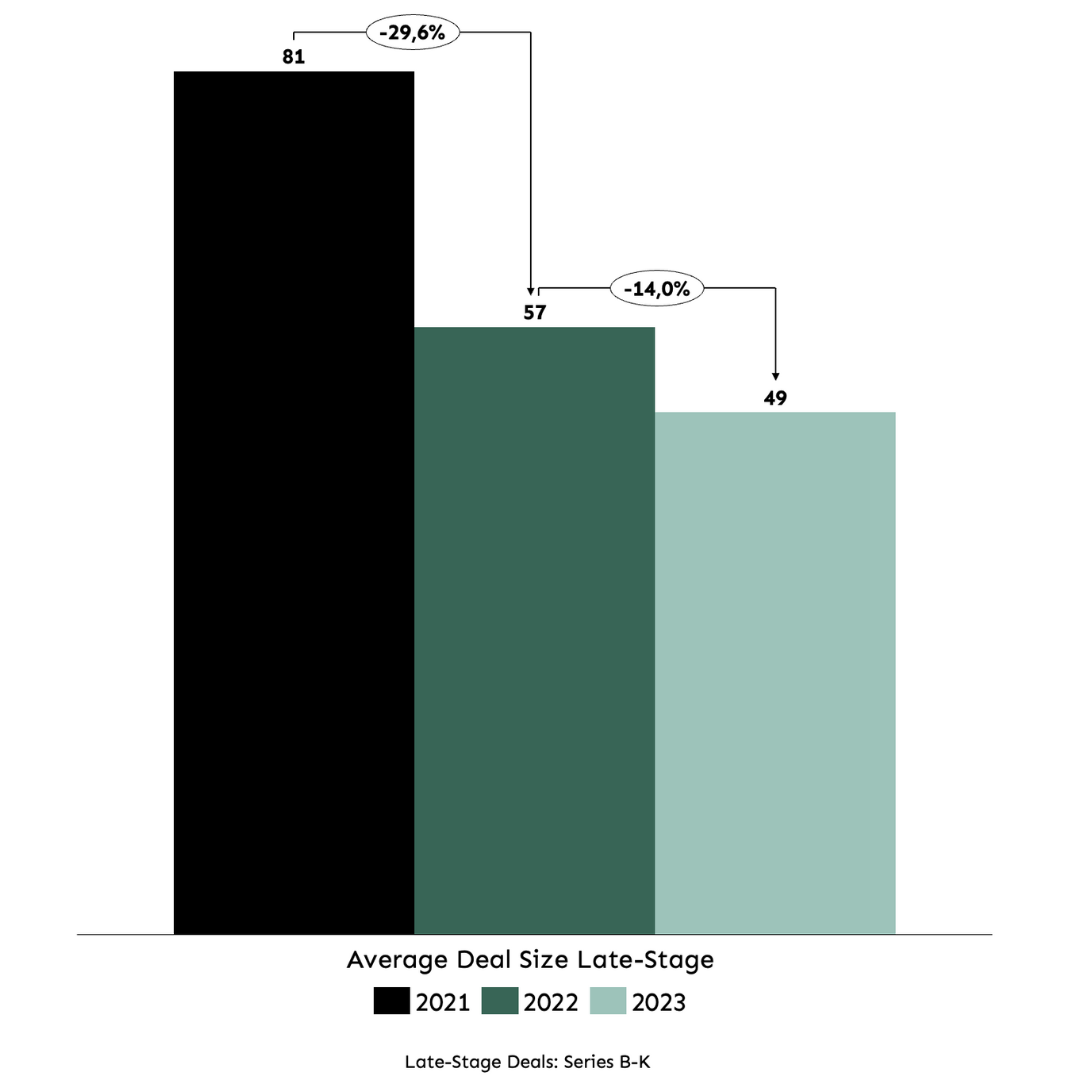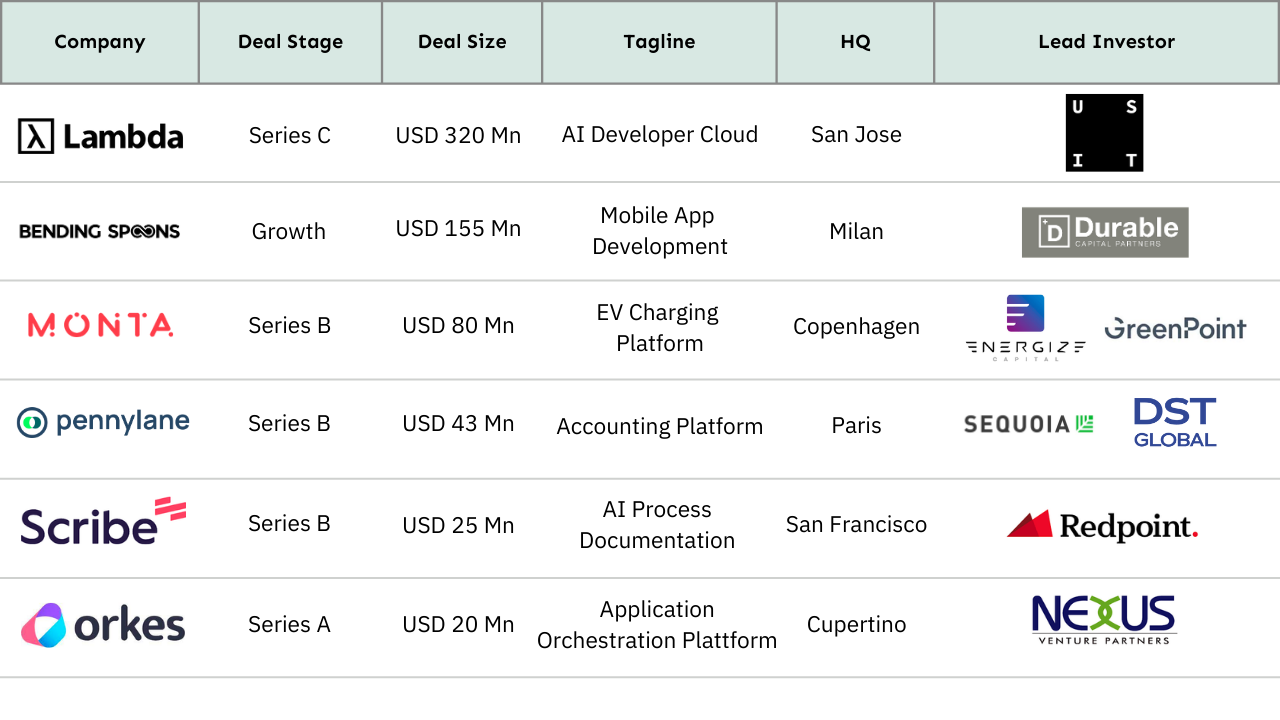2023 hasn’t quite been the year for VC, and stakeholders are still waiting for the money times of 2021 to return. But will they? After a brief recap of the most revealing VC data of 2023, we will talk about the trends and developments that are to be expected in 2024. If you want to be the first one to receive these market and data updates, make sure to sign up for our Newsletter here.
Executive Summary:
- In 2023, market challenges reduced investor interest, resulting in fewer later-stage deals and more insider rounds, affecting high-growth tech companies resorting to down rounds for funding
- Early-stage deal sizes held steady over the last three years, while late-stage deal values notably dropped since 2021
- In 2023, the market fell short of 2021 funding levels, with weakened valuations, budget constraints for startups, intensified tech sector layoffs, and overall downward valuation pressure
- Late-stage funds are facing challenges in divesting their assets due to two significant reasons: the lack of viable IPOs and the absence of large-scale M&A deals
- While recent years have taught us not to base everything on future predictions, several noteworthy trends are emerging that will likely impact the VC ecosystem: the state of IPOs, the development of bridge rounds, a more selective investment climate, advancements in AI, and how investors take advantage of the current market conditions
Deal Count Tech VC – Global

Source: Preqin March 2024
In 2023, economic uncertainty, low IPO activity, and spiked interest rates continued to constrain investors’ appetite. The largest decline has been observed in late-stage deals, but even at the Seed stage, founders have faced challenges in funding their ventures. Investors have grown increasingly risk-averse and reluctant to make long-term commitments in volatile markets. Consequently, insider rounds have become more prevalent throughout 2023. This trend has led many previously high-growth tech companies to partake in down rounds and employ creative liquidation preferences to sustain financing for operations or growth.
Tech VC Average Deal Size Late-Stage – Global

Source: Preqin March 2024
Another aspect worth examining is the trend in deal sizes. While the average deal size for early-stage rounds (Seed-Series A) has remained relatively stable at approximately USD 9 Mn over the last three years, this is not the case for late-stage deals. Deal values for late-stage rounds have substantially decreased since 2021.
Tech VC Post Money Valuations – Global

Source: Preqin March 2024
In 2023, the market has yet to reach the funding levels witnessed during the boom of 2021. The decline in tech stocks and a slowdown in the IPO market since the start of 2022 have dampened the industry’s momentum. Valuations established in 2021 did not maintain their strength in 2023, leading to many promising companies facing flat or down rounds. Startups tightened their budgets, and layoffs within the tech sector intensified throughout 2023. These combined factors have exerted downward pressure on valuations.
Outlook Tech VC 2024
One significant challenge prevalent across the industry today is the struggle faced by later-stage funds in offloading their assets. This issue stems primarily from two factors: firstly, the stagnant state of the IPO climate (as discussed below), and secondly, the scarcity of larger-scale M&A deals. These challenges are closely tied to the evolving macroeconomic landscape. Should the macro environment improve, we can expect a corresponding uptick in both IPOs and substantial M&A transactions.
A key takeaway from recent years is the unpredictability of events. None of us could have foreseen a global pandemic or a war. Moreover, this year marks what we refer to as a ‘Super Election’ year, with numerous elections poised to have a considerable influence on the macroeconomic sphere. Therefore, we don’t want to make any definitive statements regarding the potential for a macroeconomic upturn. Nonetheless, barring any major unforeseen disruptions, things should be looking better in 2025.
Tech IPO Activity

Source: Preqin March 2024
Early-stage deals are not anticipated to decrease further, but there is more discussion surrounding late-stage rounds. These tend to move in tandem with the public equity market, and as IPO activity increases, so will late-stage rounds. We have seen a tremendous fallback in public listings since a peak in 2021, but recent forecasts from many experts suggest a potential recovery in 2024. The question is whether this will be the case. Central banks are expected to cut interest rates in the coming months. Should this occur, investors may withdraw their assets from CDs and treasury bonds, choosing instead to make riskier investments with higher returns, thus making an uptick in IPOs even more likely.
Bridge Rounds
In 2023, we witnessed numerous bridge rounds, primarily aimed at reducing the burn rates of tech companies. For firms meeting performance targets, bridge rounds offer a practical strategy to weather challenging macroeconomic conditions. Looking ahead, we anticipate that companies failing to meet these performance markers may struggle to secure bridge rounds in the upcoming year. Investors are likely to be more cautious, and any available bridge funding may come with less favorable terms than what we are currently observing. Consequently, this could mean more funds becoming available for allocation elsewhere.
Selective Investment Climate
The decline in top-tier deals has intensified competition among venture capitalists, all competing for the same investments. As a result, investors are now offering higher valuations to standout startups that demonstrate strong growth potential and solid fundamentals. The AI sector is particularly impacted by this trend, with startups in this space attracting significant funding at impressive valuations.
Artificial Intelligence
AI investment surged in 2023, particularly in mega-rounds, with predictions of continued dominance. However, some investors are hesitating due to high valuations and uncertainties about the success rate in generative AI markets. What we’re witnessing currently is investors repeating the same mistakes from the VC boom era, as they struggle to maintain discipline in their hunt for the next OpenAI. Legal and regulatory challenges, both in the U.S. and internationally, might slow down the AI funding frenzy seen in 2023. There’s debate about whether the market demand from enterprises justifies the massive investments. Many early-stage AI startups might either pivot or face closure, subsequently dealing with more substantial and less hyped business problems. Meanwhile, tech giants remain highly active in AI investment, indicating continued fierce competition for supremacy in the field.
The Disciplined Investor
It is evident that the market has had better times. Investors entered during periods of high valuations and are now selling as valuations become less favorable. However, this market phase offers significant potential for disciplined investors. With much capital exiting the market, there is less pressure, presenting opportunities for investors to access comparatively inexpensive deals with the right approach and thoughtful considerations. Speaking of strategy and careful planning, we’re also noticing a trend where larger business angels, who previously invested directly, are now channeling their money into funds. This shift indicates an increasing recognition of the professional work done by venture capitalists.
Notable Transactions

Browse through the content that we at Samira share in our #knowledge channel on Slack.
- State of Private Markets: Q4 and 2023 in review
- Founder Compensation 2.0
- Earnouts to find common ground on M&A valuations
- Discount rates in venture-backed startups
- A comeback for European IPOs?
Did you know that we started publishing on Medium? Make sure to check it out here.
